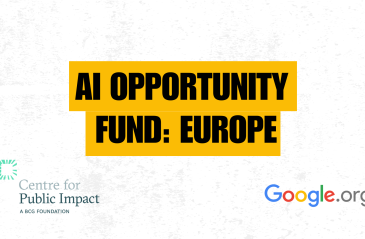
The power of storytelling in climate leadership

Only 59% of the public servants we interviewed around the world are proud to work for their organisations
Share articleA proliferation of rules can slow decision making, stifle initiative and frustrate employees
Share articleDecision rights, reward systems and career paths achieve an observable change employees’ behavior
Share articleWe put our vision for government into practice through learning partner projects that align with our values and help reimagine government so that it works for everyone.
What do you want to do when you grow up?
It's a question we're all likely to have heard at one time or another. But whether the question comes from a parent or teacher, guardian or school friend, the answer you give is shaped by your own individual instincts and preferences. Sometimes - as in my case - it can take you to law school. But for many, the bright lights of government service prove too tempting to ignore - and it's easy to see why. After all, few occupations have the power to make such a major difference in people's lives, either on the frontline or in central government departments.
Unfortunately, check back with new government hires after a few years of service and their early optimism is likely to have been replaced with a sense of weary pessimism - while some 89% of private-sector employees say they are proud to work for their organisations, only 59% of public servants agree. This result has serious implications, as governments worldwide have no shortage of urgent problems to address. From Brexit in Europe to addressing the end of the commodities boom here in Australia to ensuring the new administration in Washington hits the ground running, we need the best and brightest to be fully engaged and up for the challenge. So what can be done?
It's important at the outset to understand what might lie behind this change of mood. It can't all be down to graduates finding the world of work to be very different from their college or university days. Actually, the reality is that the abundance of rules and regulations in the public sector can have the opposite effect to what was intended. As they proliferate, they can harden into bureaucracies that slow down decision-making, stifle initiative, discourage cooperation, and lead to frustrated and dispirited employees.
But it doesn't have to be this way. At BCG we have developed an approach which we call "Smart Simplicity", and it helps leaders to simplify their organisations, take a systematic view of challenges, and create systems that promote the good behaviour and actions needed to help the organisation achieve its mission. The result, in our experience, is employees who approach their work with greater pride and commitment and feel more fulfilled.
So, how does it work?
Imagine an organogram. Then add another one. And then another. The result is an organisation where good ideas and people are rendered unable to move from A to B. Room for manoeuvre and any sense of flexibility are long since cast aside - to the detriment of all involved. Smart Simplicity is designed to cut through these organisational complexities by encouraging greater collaboration and cooperation. Based on game theory, behavioural economics, and sociology, it essentially connects the mission of an organisation with the purposes and passions of its employees.
It is built around two basic assumptions: performance is the result of what people do on the job, and behaviour is driven by rational responses to the workplace. The first step is to understand the existing system and why people behave as they do. We kick this off with a process which involves interviews - enabling us to discern what drives individuals' choices and actions - and a “complicatedness” survey, which helps us rapidly scan the organisation's context. This enables us to identify what needs to be corrected in order to make the desired behaviours the logical choice for employees.
Leaders can then simplify the organisation by developing “minimal sufficient” solutions, such as changing decision rights, removing signatures from certain documents, altering the sequence of steps in a process, or changing how work is allocated among staff members. These solutions are often a series of low-tech, cost-effective changes that together create a new context, and therefore start to change behaviour.
Smart Simplicity is not a panacea for every organisational challenge. But if a government leader has already tried standard remedies without seeing enough progress, or if reviews, structural changes and employee training programmes have made little difference - with employees remaining disengaged, risk-averse and operating in silos - then it is clearly time to try something new. Another opportunity arises when a leader first starts work. New leaders may receive briefings and organisational diagrams aplenty, but gaining a true understanding of how it all really operates requires more, which is where Smart Simplicity can help.
But this is an ongoing process. Let's face it, pledging to cut bureaucracy is a line that has long been used by politicians the world over, and its enduring prevalence underlines the challenges involved. But this is no time to lose heart. Streamlining operations and unleashing the power and potential of committed and inspired government employees is a prize worth fighting for - and Smart Simplicity is a powerful tool to help policymakers turn this vision into widespread reality.
Want to learn more? Then check out this longer article, The Smart and Simple Way to Empower the Public Sector on BCG Perspectives.











